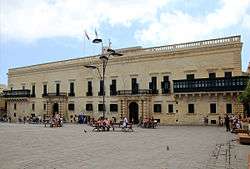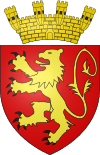Conspiracy of the Slaves
|
The revolt was to begin at the Grandmaster's Palace in Valletta | |
| Native name | Konfoffa tal-ilsiera |
|---|---|
| Date | 29 June 1749 |
| Location | Valletta, Malta |
| Also known as | Revolt of the Slaves |
| Type | Attempted slave rebellion |
| Organised by | Mustafa, Pasha of Rhodes |
| Outcome | Revolt suppressed |
| Charges | Most rebels executed |
The Conspiracy of the Slaves (Maltese: Konfoffa tal-ilsiera), also known as the Revolt of the Slaves, was a failed plot by Muslim slaves in Hospitaller-ruled Malta to rebel, assassinate Grand Master Manuel Pinto da Fonseca and take over the island. The revolt was to have taken place on 29 June 1749, but plans were leaked to the Order before it began, and the plotters were arrested and most were later executed.
Background
In the mid-18th century, there were around 9000 Muslim slaves in Hospitaller-ruled Malta.[1] They were given a substantial amount of freedom, being allowed to gather for prayers.[2] Although there were laws preventing them from interacting with the Maltese people, these were not regularly enforced. Some slaves also worked as merchants, and at times were allowed to sell their wares in the streets and squares of Valletta.[3]
In February 1748, Hungarian, Georgian and Maltese slaves on board the Ottoman ship Lupa revolted, taking over 150 Ottomans prisoner, including Mustafa, the Pasha of Rhodes. They sailed the captured ship to Malta, and the prisoners were enslaved. However, Mustafa was placed under house arrest on the insistence of France due to the Franco-Ottoman alliance, and was eventually freed. He converted to Christianity and married a Maltese woman, so he was allowed to remain in Malta.[4]
Plot
Mustafa planned to organize a slave revolt on 29 June 1749. The day was the feast of Saints Peter and Paul (Maltese: L-Imnarja), and a banquet was to be celebrated at the Grandmaster's Palace in Valletta. Slaves were to poison the food at the banquet as well as within the auberges and other palaces.[5] After the banquet, a small group of slaves would assassinate Grand Master Manuel Pinto da Fonseca in his sleep, while 100 palace slaves would overpower the guards. They would then attack the Slaves' Prison to free the remaining Muslims, while others were to attack Fort Saint Elmo and take weapons from the armouries. The Ottoman Beys of Tunis, Tripoli and Algiers were to send a fleet which was to invade Malta upon receiving a signal from the rebels.[6]
Discovery and aftermath
The plot was discovered on 6 June, three weeks before it was to take place.[7] Three slaves had met in a coffee shop in Valletta to win the support of a Maltese guard to the Grand Master, and began to quarrel. The shop owner, a Jew called Giuseppe Cohen, overheard them mention the revolt and reported this information to the Grand Master. The three slaves were arrested, and they revealed details of the plan after being tortured.[6]
The leaders were subsequently arrested, and 38 of them were tried and executed. Some plotters reportedly converted and asked to be baptized just before being killed. 125 others were hanged in Palace Square in Valletta,[5] while 8 were branded with the letter R (for ribelli) on their forehead, and were condemned to the galleys for life.[6] On the insistence of France, Mustafa Pasha, who was behind the revolt, was not executed but was taken back to Rhodes on a French vessel.[4]
Consequences

Following the foiling of the plot, Grand Master Pinto reported the events to his ambassadors in Europe. Laws restricting the movement of slaves were made stricter. They could not go outside the city limits, and were not to approach any fortifications. They were not allowed to gather anywhere except from their mosque, and were to sleep only in the Slaves' Prison. Moreover, they could not carry any weapons or keys of government buildings.[6]
Giuseppe Cohen, who had revealed the plan, was given an annual pension of 300 scudi from the Order's treasury and another 200 scudi from the Università of Valletta.[6] Cohen was also given a house in Valletta, which had previously been the seat of the Università until it moved to new premises in 1721. The house remained in the Cohen family until 1773, when they were given an annuity and the building was taken over to house the Monte di Pietà.[8]
In literature
The poem Fuqek Nitħaddet Malta, an early example of Maltese literature, was written by an anonymous author some years after the attempted revolt.[9]
In 1751, Giovanni Pietro Francesco Agius de Soldanis published Mustafà Bassà di Rodi schiavo in Malta, o sia la di lui congiura all'occupazione di Malta descritta da Michele Acciard about the conspiracy. He published it under the pseudonym Michele Acciard, an Italian who de Soldanis had met in his travels (although some documents suggest that Acciard was actually involved in its writing as well).[10] The book caused considerable controversy since it attacked the Order and argued for the rights of the Maltese. This resulted in it being banned in Malta, and de Soldanis had to go to Rome to defend himself in front of Pope Benedict XIV. He returned in 1752 and was forgiven by Pinto.[11]
In 1779, Pietro Andolfati wrote a play about the revolt, entitled La congiura di Mustafa Bassa di Rodi contro i cavalieri Maltesi: ovvero le glorie di Malta (The conspiracy of Mustapha Pasha of Rhodes against the knights of Malta, or the glories of Malta).[12]
References
- ↑ Eltis, David; Bradley, Keith; Cartledge, Paul (2011). The Cambridge World History of Slavery: Volume 3: AD 1420-AD 1804. Cambridge University Press. p. 144. ISBN 9780521840682.
- ↑ Fisher, Humphrey J. (2001). Slavery in the History of Muslim Black Africa. London: C. Hurst & Co. Publishers. p. 31. ISBN 9781850655244.
- ↑ Goodwin, Stefan (2002). Malta, Mediterranean Bridge. Greenwood Publishing Group. p. 43. ISBN 9780897898201.
- 1 2 Castillo, Dennis Angelo (2006). The Maltese Cross: A Strategic History of Malta. Westport: Greenwood Publishing Group. p. 91. ISBN 9780313323294.
- 1 2 Abela, Mario. "Il-Konfoffa ta' l-ilsiera" (PDF). hostingbydavi.info (in Maltese). Archived from the original (PDF) on 29 September 2015.
- 1 2 3 4 5 Sciberras, Sandro. "Maltese History - E. The Decline of the Order of St John In the 18th Century" (PDF). St. Benedict College. Archived from the original (PDF) on 26 June 2015.
- ↑ "Very rare contemporary account of an abortive Muslim slave revolt in Malta". forumrarebooks.com. Archived from the original on 29 September 2015.
- ↑ Denaro, Victor F. (1958). "Houses in Merchants Street, Valletta" (PDF). Melita Historica. 2 (3): 161.
- ↑ Cassar, Mario. "L-Istorja tal-Ilsien Malti". L-Akkademja tal-Malti (in Maltese). Archived from the original on 23 September 2015.
- ↑ "Patriotism, Deception and Censorship – De Soldanis and the 1751 account of the uprising of the slaves". Book Distributers Limited. Archived from the original on 26 April 2016.
- ↑ Carabott, Rosabelle (2012). De Soldanis – L-Esploratur tal-Ilsien Malti (PDF) (in Maltese). Heritage Malta. pp. 4–5. ISBN 9789995702854. Archived from the original (PDF) on 11 December 2015.
- ↑ Andolfati, Pietro (1779). La congiura di Mustafa Bassa di Rodi contro i cavalieri Maltesi: ovvero le glorie di Malta (in Italian).


